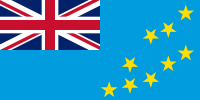Fenua Tapu
It is the most southern and most eastern islet of Nui and is the largest (area 1.38 km). Most Nuians live on the western end of Fenua Tapu, where a village including the settlements of Alamoni - Maiaki and Manutalake - Meang (Tanrake) lies.
A Dutch expedition (the frigate Maria Reigersberg) found Nui on the morning of June 14, 1825 and named Fenua Tapu as Nederlandsch Eiland.
A New Island in the Pacific.— In July last, the Pollux, Dutch sloop of war, Captain Eeg, discovered a new and well-peopled island in the Pacific, to which the name of Nederlandich Island was given : its latitude and longitude laid down at 7° 10' S., and 177° 33' 16" E. from Greenwich. The natives were athletic and fierce, great thieves, and, from their shewing no symptoms of fear when muskets were discharged, evidently unacquainted with the effects of fire-arms.
-
Dutch map of the island, made in June 1825
-
View of the main island
-
View of the atoll
References
- ^ Map of Nui. Tuvaluislands.com. Archived from the original on 2013-10-14. Retrieved 2013-10-12.
- ^ British Admiralty Nautical Chart 766 Ellice Islands. United Kingdom Hydrographic Office (UKHO). 21 March 1872.
- ^ Sotaga Pape (1983). "Chapter 10 – Nui". In Laracy, Hugh (ed.). Tuvalu: A History. Institute of Pacific Studies, University of the South Pacific and Government of Tuvalu. p. 71.
- ^ "Population of communities in Tuvalu". Thomas Brinkhoff. 11 April 2012. Retrieved 20 March 2016.
- ^ "Dutch warships available but not in active service in August 1834". 3 December 2011. Retrieved 22 March 2016.
- ^ "Pieter Troost: Aanteekeningen gehouden op eene reis om de wereld: met het fregat de Maria Reigersberg en de ...". 1829. Retrieved 14 August 2017.
- ^ The Australian newspaper, Saturday 25 November 1826
External links
- Map of Nui showing Fenua Tapu Archived 2011-08-06 at the Wayback Machine
7°14′45″S 177°8′50″E / 7.24583°S 177.14722°E



